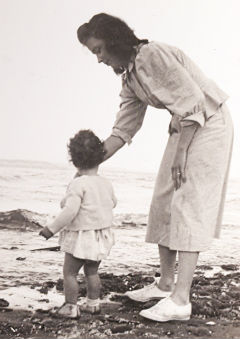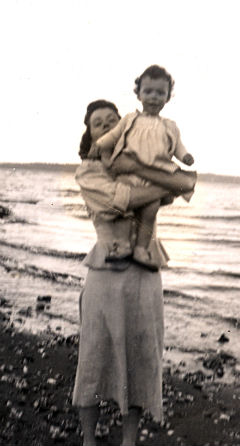What We Can Learn From Looking
Today’s guest post is by MaryAnn F. Kohl, author of 20+ books about art for children. MaryAnn owns Bright Ring Publishing, and is also a literary agent to the education and parenting genre. MaryAnn has always been a big believer in creativity and art for kids.
My mom died when I was a new, young mother. Until then, I had always been the child to both of us, the two of us never really knowing each other as one adult to another. I know I missed something special losing her so young. I longed to know her. Recently I realized that there was much I could learn about my adult mother from pictures stashed away in our old photo albums. And so I began to look with new eyes.
 In these 1948 snapshots, we are seen frolicking on the beach of Bainbridge Island in Washington state, our island home. We’re exploring a rocky beach, the tide is low, seaweed is slimy, the exposed sand is black and muddy on our shoes. And yet, here we are in our very nice clothes without a care in the world.
In these 1948 snapshots, we are seen frolicking on the beach of Bainbridge Island in Washington state, our island home. We’re exploring a rocky beach, the tide is low, seaweed is slimy, the exposed sand is black and muddy on our shoes. And yet, here we are in our very nice clothes without a care in the world.
 What I notice most is that my mom has on a lovely linen suit, and my muddy shoe prints are all over the front of her skirt. She doesn’t mind. She loves me. She loves our time on the beach together. She is gentle with me, and thoughtful. She cares that I am learning and finding joy in the adventure. I am safe, I am protected, I am feeling free to learn and explore with her strength and love nearby.
What I notice most is that my mom has on a lovely linen suit, and my muddy shoe prints are all over the front of her skirt. She doesn’t mind. She loves me. She loves our time on the beach together. She is gentle with me, and thoughtful. She cares that I am learning and finding joy in the adventure. I am safe, I am protected, I am feeling free to learn and explore with her strength and love nearby.
Did I always know this about her, that she was this kind of mother? I knew, but the pictures I see of us together on this muddy slippery beach tell me more than words could ever say. The silent voices that I hear as I look at the two of us together are, “I love you. I will take care of you. You are precious to me.”
I think every child wants to know they are loved, safe, and precious. A picture truly is worth a thousand words, and these pictures speak volumes that tell me everything I needed to know.